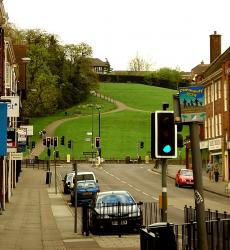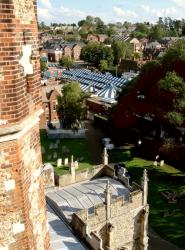Hermitage Road and Windmill Hill
This photograph is taken on Windmill Hill looking down toward Hermitage Road. The two are linked by the wealthy quaker banker called Frederic Seebohm who had a large house on Bancroft, known as the Hermitage. He gave part of his back garden to form Hermitage Road in 1875. (Roughly the same time the windmill on Rawlings Hill burnt down) He aquired the land and built the Hitchin Girls’ Grammar School in 1907 and then his two daughers donated the rest of the hill to the people of Hitchin in 1921.
The photograph here is of Windmill Hill looking up from Hermitage Road. Originally called Rawlings Hill, because of the Mill there, it was then known as Windmill Hill after if burnt down as mentioned above. The miller’s cottage was still standing on the Hollow Lane side of the hill until 1950; and there was a house built on the hill in the 1920’s, but was unpopular and is no longer there. The two photographs illustrate quite well I think, just how green the centre of Hitchin is.
Aerial View of Hitchin Market
This aerial shot taken from the top of the tower of Hitchin’s St. Mary’s Church, illustrates well that the market area is in a ‘hollow’ between raised areas. What you can’t see from here is that fact that The River Hiz runs through the middle of them and under the market. (Canalised sometime in the 1920s) From ground level, it is glaringly obvious that the designers of the more modern market (Moved many times around Hitchin) had no real thoughts of trying to fit it in to its surroundings; being concrete, brick and garish metal roofs. They could have designed it to ‘echo’ the church near it, the way that St Saviour’s Cloisters do that were built in the 1920s-30s.
Widmill Hill Steps
These steps and surrounding retaining wall of Windmill Hill (Off Hollow Lane) were built in 1931 and probably the wonderful apartments of Garrison Court were built at the same time too. This view is not often shown in photographs of Windmill Hill due to it’s supposed less dramatic prospect or vista; but is actually preferred because it is quieter than the Hermitage Road side.
Love Hearts Graffiti (Part 2)
Around Hitchin appeared some wonderful graffiti such as this one on the wall that forms part of the car park opposite St. Mary’s Church and the River Hiz. I would much rather have this sort of graffiti than the usual crass ‘scribble your name’ type that seems to dominate anywhere that teenagers hang around. Perahps we have a Banksy of our very own.
Tilehouse Street Railings

Outside Neves Solicitors at 4 Tilehouse Street, are a lovely old set of railings, though they aren’t the original railings. Those would have been ripped out during World War 2 for recycling for armaments. These newer ones have been sensitively done and have an ‘old’ look about them and their settings don’t look re-done in any way. A nice detail often overlooked when people take photographs.
William Ransom Physic Garden
Physic being Greek for ‘Body’ I think belies the garden’s supposed usage. Ornamental, rather than functional. It is called the ‘William Ransom Physic Garden’ after the 19th Century Millionaire Hitchin Physician and Chemist, William Ransom, who founded the pharmaceutical chemist in Bancroft (Which is now Sainsbury’s and the new Lavendar Fields apartments); and is laid out with plants and herbs that the 17th Century Herbaslist Nicholas Culpeper might have used medicinally too.
The garden was opened by Prof Harold Ellis on 20th May 1990 after the land was given over from Hitchin Museum that lies immediately to it’s west. It opens daily as part of the Hitchin Museum Experience and is a wonderful haven of tranquility. Note worthy is the Bronze/Brass sundial that has been made to resemble a Physican’s/Herbalist’s/Chemist’s Mortar and Pestle. Art using form to immitate function. A nice touch I think.
Market Place Cabin
This Edwardian Cabmen’s Shelter used to stand on the forecourt of Hitchin Railway Station and was paid for by the donations of rail users collected by Edward Boxall who ran a cab business from The Red Lion that used to be in Bucklersbury (Now the new age shop ‘Harvest Moon’) It was used as a shelter for cab drivers waiting for fares until 1976 when it was sold by British Rail and stood in the garden of John and Patsy Myatt. They donated it to the town, whereby it was restored and promoted by The Hitchin Historical Society and Hitchin businesses. On the 10th Of October 1998, it was finally handed over to the Hitchin community and moved to The Market Place.
Since then, the Hitchin Historical Society have lampooned the Cabin on their Christmas cards; one famous card’s comments being, it was designed by a little known Chinese architect Lu Tien. He thought he’d been asked to design a lantern, and when the drawings were returned to the railway company, the engineers misunderstood his size specifications and accordingly built it as a full sized shelter. The text was littered with shameless clues such as the name Crisp. E. Duck as well as the name Lu Tien, which is a parody of Sir Edward Lutyens name. (A great Victorian Architect) Unfortunately, this story was picked up by a local railway historian who failed to spot the obvious clues and included the curious history of the cabin in his recently published book on the local railway.
Bridge Street Bridge
Bridge Street in Hitchin takes its name from the bridge itself, crossing the River Hiz, that was built in 1784 and rebuilt in 2001. ‘Bridgefoot‘ is also mentioned in a survey dated from 1676. At one end of Bridge Street is ‘The Triangle’ (because of a triangular bit of land that had a tree with railings around it) and the other end leads to The Priory and Tilehouse Street.
Earlier on in Hitchin’s Medieval history, the road was known as Spital or Spittle Street as it led to Spital Field that had a Hospital on it. (Spital being a contraction of Hospital)









